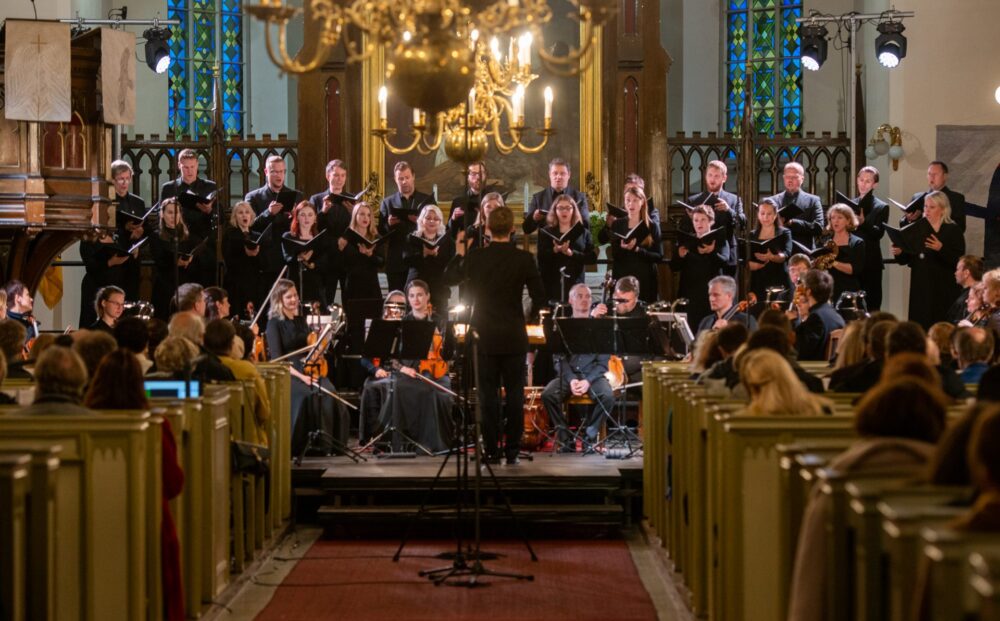
19:00 – 20:00
University of Tartu assembly hall
Venue info + map
Tickets 20/15€
Estonian Philharmonic Chamber Choir
Tallinn Chamber Orchestra
Soloists Yena Choi, Cätly Talvik, Laura Štoma, Cätly Talvik, Toomas Tohert, Kristjan-Jaanek Mölder, Geir Luht
Conductor Tõnu Kaljuste
Tauno Aints – Wind Always Wins for chamber choir and string orchestra, text by Heli Illipe (2023, premiere)
Laps heitis murule
Kui sa leiad suure kivi
Hüüa! Ma tulen
Soloist Cätly Talvik (alto)
Enne pilkast pimedust
Soloists Laura Štoma (soprano), Cätly Talvik (alto), Toomas Tohert (tenor), Kristjan-Jaanek Mölder (bariton), Geir Luht (bass)
Sinu koduaknast paistab
Tuulele vastu ei saa
Soloists Kristjan-Jaanek Mölder, Rainer Vilu (bariton)
Arvo Pärt – L’abbe Agathon (2004/2008)
Soloist Yena Choi
Erkki-Sven Tüür – Deep Dark Shine (2020)
Lepo Sumera – Concerto per voci e strumenti (text Doris Kareva, 1997)
I Furioso
II Moderato
III Allegro misterioso
Soloists Mariliis Tiiter (soprano), Cätly Talvik (alto), Toomas Tohert (tenor), Kristjan-Jaanek Mölder (bariton)
Rudolf Tobias – The Thief (text Karl Eduard Sööt, 1905)
Veljo Tormis – Curse Upon Iron (1972)
Soloists Toomas Tohert (tenor), Geir Luht (bass)
“Wind Always Wins” for mixed choir and string orchestra (2023, premiere, lyrics Heli Illipe). Tauno Aints: “I discovered Heli Illipe lyrics when we produced the concert performance “Last Angel” together with Indrek Hargla. These highly figurative poems, speaking of the human condition, inspired me to create a cycle whose parts form a whole. I wanted the development line to be followed in a suggestive and figurative way. Of all the texts, I selected those that speak about subjects that are close to my heart, about relationships, about the way of seeing the world.”
Composed for soprano and eight violoncellos, L’abbé Agathon is inspired by Maladrerie Saint-Lazare, one the oldest leper hospitals in Europe. The remains of the hospital, dating from the 12th century, lie close to Beauvais. Pärt came across a 4th century legend concerning Agathon in a book of stories about the Desert Fathers that describes the life of Christian monks in the deserts of Egypt. The legend tells us of the meeting between the hermit Agathon and a leper who tested Agathon several times. Only after these trials, the leper revealed himself as an angel sent by God.
Composed for soprano and eight violoncellos, L’abbé Agathon is inspired by Maladrerie Saint-Lazare, one the oldest leper hospitals in Europe. The remains of the hospital, dating from the 12th century, lie close to Beauvais. Pärt came across a 4th century legend concerning Agathon in a book of stories about the Desert Fathers that describes the life of Christian monks in the deserts of Egypt. The legend tells us of the meeting between the hermit Agathon and a leper who tested Agathon several times. Only after these trials, the leper revealed himself as an angel sent by God.
Arvo Pärt: “St. Agathon is associated with several legends involving lepers. One of the best-known says that Agathon’s love was so great that he was willing to exchange his body with that of a leper. Three musical situations dominate the piece: Agathon on the way to the market, characterised by his gait heavy with the leper on his shoulders, the dialogues between the leper and Agathon, and the life at the market. The coda is a surprising dramaturgical turning point – but also a logical conclusion to the idea which brings the entire notion of Agathon to a head.”
The world premiere of the composition took place in May 2004 in Beauvais, France, performed by soprano Barbara Hendricks and L’Octuor de violoncelles de Beauvais, who also commissioned the work. L’abbé Agathon is dedicated to musicians who premiered it. Pärt’s list of works also includes versions for soprano, four violas and four cellos (2005) and for soprano, alto or baritone, female choir and string orchestra (2008).
From the Sayings of the Desert Fathers
L’abbé Agathon, se rendant un jour dans la ville pour vendre de menus objets, trouva le long de la route un lépreux qui lui demanda: “Où vas-tu?”
L’abbé Agathon lui dit: “A la ville vendre des objets.”
Le lépreux lui dit: “Par charité, porte-moi là-bas.” L’ayant pris, le vieillard le porta à la ville.
L’autre lui dit alors: “Dépose-moi à l’endroit où tu vends tes objets.” Et l’abbé Agathon fit ainsi. Quand il eut vendu un objet, le lépreux lui demanda: “Combien l’as-tu vendu?”
“Tant.”
“Achète-moi un gâteau.” Il l’acheta. Quand il eut vendu un autre objet, l’autre lui dit: “Et celui-ci, combien l’as-tu vendu?”
“Tant.”
“Achète-moi telle chose.” Le vieillard l’acheta encore. Quand il eut vendu tous ses objets et qu’il voulut partir, le lépreux lui dit: “Tu t’en vas?”
“Oui.”
“Je t’en prie, par charité, reporte-moi à l’endroit où tu m’as trouvé.” L’abbé Agathon prit le lépreux et le reporta à cet endroit. Celui-ci lui dit alors: “Béni es-tu, Agathon, par le Seigneur du ciel et de la terre.”
Agathon leva les yeux mais il ne vit plus personne, car le lépreux était un ange du Seigneur venu le mettre à l’épreuve.
The Abbot Agathon went one afternoon into town, to market to sell his wares and there, along the road was a leper. The leper said: “Where will you go?”
The Abbot Agathon replied: “Into town selling humble wares.”
So the leper replied: “For mercy’s sake, take me forth with you.” So he did. Agathon took the leper into town.
Then the leper spoke: “Transport me to the market stalls where you sell all your wares.”
And the Abbot Agathon did as he was asked. When the monk had made his first sale, the leper dared to ask him: “How much have you sold it for?”
“Much.”
“Kind Sir, then buy me a cake.” And he obliged. When the monk had sold another ware, the leper said: “This item here, how much did it fetch you?”
“Much.”
“Then purchase it for me.” Agathon did the leper’s will. When Abbot Agathon sold all his wares, and then desired to leave, the leper said: “You depart?”
“Yes.”
“If you will, for mercy’s sake, take me back along the road where I lay today.” The Abbot Agathon lifted the man, took the leper back to where he’d lain. When he had, the leper said: “Blest indeed are you, Agathon. Blest indeed are you by Jesus, the Lord of Heaven and of the Earth.”
Agathon raised up his eyes, but he saw not anyone. For the leper was an angel of the Lord come to put him to the trial.
Translation by Cori Ellison
From the Arvo Pärt Centre website
Deep Dark Shine (2020). Erkki-Sven Tüür: “When I began composing this work in the early months of 2020, I was thinking of the fascination of the dark and unknown depths that we perceive as both frightening and alluring. We can feel something like this when we gaze into the starry sky at night, or imagine the ocean depths where fluorescent life forms move. In the deepest layers of our subconscious, we can also experience a certain dim glow. In the spring of 2022, however, this music took on a completely different connotation. With the wisdom of retrospection, I can say that I do remember my state of mind a little over two years ago: there was an underlying anxiety about something coming that would bring many changes. Indeed, the planned premiere was cancelled because of the pandemic. But the forces of darkness that the world is once again facing were undoubtedly beyond the imagination of most people. Including mine. Today, this music sounds to my ears like a scream from the depths. In the hope that, even in the darkest hour of darkness, there is still a glimmer of light. The musical architecture is based on polyphonic, constantly evolving chords, with a melodic line that gradually grows from the central sound, presented by the violas. These chords are based on a dark layer of contrabasses and cellos, above which a layer of violins is reflected in a luminous cloud. Time and again, the musical development of motifs originates in the low registers: cellos and contrabasses. They are gradually joined by violas and violins. Now and again, we perceive two parallel layers moving at different speeds: rapid movements that gather and then disperse, contrasted by a slow flow.”
Deep Dark Shine was premiered by Ensemble Resonanz, the Scottish Ensemble and the Trondheim Soloists at The Bridge Festival in Glasgow, Scotland in 2022. The Estonian premiere was given on 17 March 2023 at the Great Hall of the Estonian Academy of Music and Theatre by the Tallinn Chamber Orchestra and conductor Tõnu Kaljuste.
Lepo Sumera’s Concerto per voci e strumenti (Concerto for Voices and Instruments, 1997, lyrics by Doris Kareva) was commissioned by Tõnu Kaljuste for the festival VoxEstFest. The piece has three movements (slow–fast–slow), like a classical instrumental concerto. This work represents the bright, humorous side of Sumera’s compositional output. The concert is based on Doris Kareva’s evocative, hilarious lyrics, with the music adding a further twist.
The concerts of Estonia’s leading ensembles, the Estonian Philharmonic Chamber Choir and the Tallinn Chamber Orchestra, conducted by Tõnu Kaljuste, are always highly awaited events. This year’s performance includes a work by Arvo Pärt, an opus by Erkki-Sven Tüür, premiered in Glasgow a year ago, a new work by Tauno Aints and a playful vocal-instrumental concert by Lepo Sumera. The concert features Yena Choi, a brilliant soprano member of the Estonian Philharmonic Chamber Choir, as soloist.
The concert will be live-broadcasted by Klassikaraadio.
